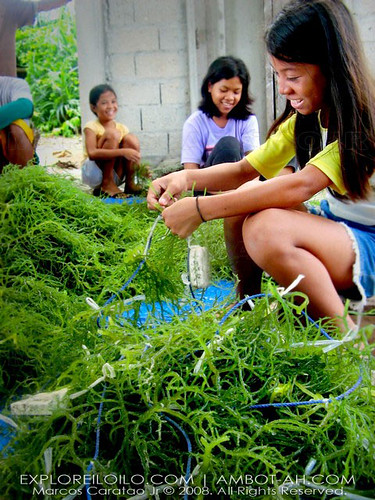

Seaweeds are used to treat or prevent goiter, glandular troubles, stomach disorders, intestinal and bladder difficulties, unusually profuse menstrual flow, high-blood pressure, and high plasma-cholesterol level.

The fertilizer is made from brown seaweed, cattle manure, stabilizing compounds and an organic binder fortified with soluble compounds of a number of nutrients. In Kidapawan City, Jose Riga developed an all-purpose seaweed-based organic fertilizer and soil conditioner in stabilized pellets. The high potassium content of brown seaweeds like Sargassum, Turbinaria, Hormophysa, and Hydroclathrus make them ideal substitutes for costly fertilizer. The seaweed noodle is rich in calcium and magnesium andcan be cooked into pansit canton, pansit luglug, spaghetti and carbonara. Residents of Tiwi, Albay have developed a pansit (noodles) made from seaweed, which has health benefits. Species of Cladophora, Enteromorpha, Chaetomorpha, and Gracilaria are used to supplement or substitute for fishfood for cultured herbivorous fish.

So far, four species – Halimada, Hypnea, Sargassum, and Asparagopsis – have been used as feed or fodder for livestock. Some of these varieties are processed into jams, jellies, candies, pickles, baby’s food, and gulaman bars. Philippines, home to 390 species of seaweeds, have identified the numerous varieties as having economic value as food, animal feeds, fertilizers, diet supplement, medicines, and raw materials for industrial products.Ħ0 varieties are edible, among them are gulamang dagat, gamet, pocpoclo, culot, lato, guso, barls-barls, bulaklak bato, and balbalolang. The Philippines is noted for the culture of seaweeds along with Japan, China, Korea, and Taiwan. Commercial seaweed farmers first succeeded in cultivating Eucheuma in the reef areas of Mindoro, Aklan, Cuyo, Zamboanga, and Tawi-Tawi.įood and Agriculture Organization reports that seaweed farming is presently limited to a few countries in East Asia making it a high value crop with a high demand in the world market. Max Doty, a marine botanist at the University of Hawaii, and his local counterparts, the first technology for culture of Eucheuma was introduced to industry in 1973. Philippines, a pioneer in seaweed farming, have cultures of Porphyra, Eucheuma, and Caulerpa in marine farms have been recorded as early as the 1960s. These regions account for 60% of the country’s total production. Most of them are found in coastal barangays in Western Mindanao, Central and Eastern Visayas, and Southern Tagalog. Currently, there are more than 150,000 hectares of seaweed farms throughout the country. “The average income per family is P15,000 per 60 days per one-fourth hectare.” As an industry, seaweed farming or the gathering of natural stocks is a viable venture. Guerrero III, the PCAMRD executive director. It grows abundantly in shallow reef and lagoons with less than two meters in depth during high tide.“Our seaweed production is still the biggest aquaculture producer of the country providing livelihood to more than 100,000 poor coastal families,” reports Dr. With a coastline of 36,289 kilometers, Philippines has marine resources that could provide food to millions of Filipinos and even livelihood to a great number of rural families.


 0 kommentar(er)
0 kommentar(er)
